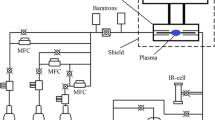Conclusions
-
1.
With the presence in the composition of the boron carbide-base impregnating medoum of a liquid phase possessing electrical conductivity, boriding is provided primarily as the result of electrochemial oxidation (corrosion) of the boron with formation of ions of the lowest valence form.
-
2.
A high boriding rate with high-frequency induction heating is obtained with a content in the impregnating medium of 3–6% B2O3 or 10–15% Na2B4O7, with which the optimum conditions are created for chemical or electrochemical oxidation of the boron as the result of access of oxygen and nonuniform aeration of the surface of the boron carbide particles.
-
3.
One of the effective means of accelerating the process of boriding from boron carbide with participation of the liquid phase is intensification of the process of electrochemical oxidation of boron by aeration of the impregnating medium or addition to the composition of the medium of metals possessing a lower affinity for oxygen than boron such as in the form of oxides as cation depolarizers.
Similar content being viewed by others
Literature cited
G. V. Samsonov and A. P. Énik, Refractory Coatings [in Russian], Metallurgiya, Moscow (1973).
N. G. Ilyushenko et al., "Diffusion coating of metals in molten salts." in: High-Temperature-Resistant and Heat-Resistant Coatings. Proceedings of the Fourth All-Union Conference on High-Temperature-Resistant Coatings [in Russian], Nauka, Leningrad (1969), pp. 105–120.
L. G. Voroshnin and L. S. Lyakhovich Boriding of Steel [in Russian], Metallurgiya, Moscow (1978).
B. N. Polyakov, "Features of the mechanism of oxygen activation of the boriding process with rapid high-frequency induction heating," Metalloved. Term. Obrab. Met., No. 5 (1982).
V. N. Tkachev, B. N. Polyakov and V. I. Sidel'nikova, "The microstructure and properties of boride cases formed in induction heating of steel," Metalloved. Term. Obrab. Met., No. 1, 2–5 (1979).
T. Erdey-Gruz, Chemical Sources of Current [Russian translation], Mir, Moscow (1974).
V. S. Chirkin, The Thermophysical Properties of Materials (Handbook) [in Russian], Fizmatgiz, Moscow (1959).
Additional information
Rostov-on-the-Don Scientific-Research Institute for Machine Building Technology Scientific and Production Union. Translated from Metallovedenie i Termicheskaya Obrabotka Metallov, No. 12, pp. 10–13, December, 1988.
Rights and permissions
About this article
Cite this article
Polyakov, B.N. Mechanism of oxygen activation of the boriding process in the presence of a liquid phase. Met Sci Heat Treat 30, 895–899 (1988). https://doi.org/10.1007/BF00775307
Issue Date:
DOI: https://doi.org/10.1007/BF00775307




